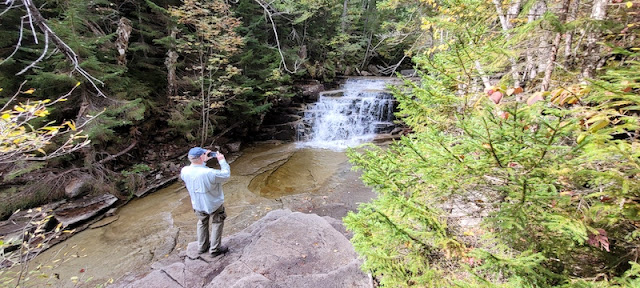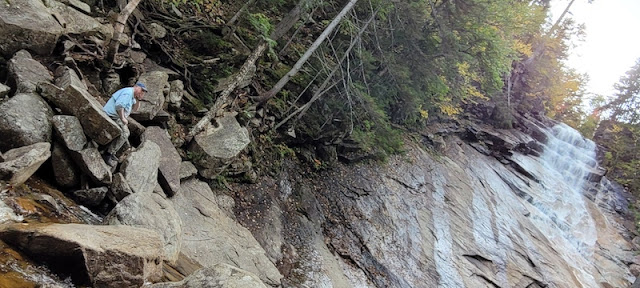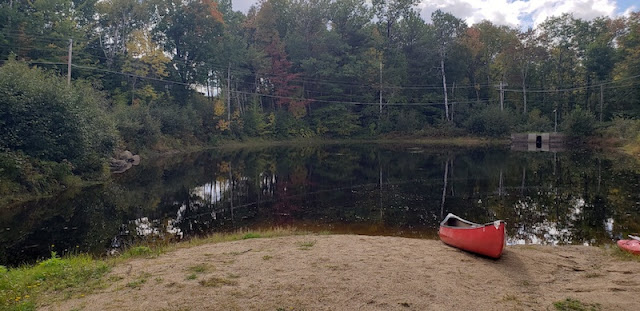New England Fall Foliage Trip 2021
September 25-October 1, 2021
New Hampshire continued to provide us with scenes we had imagined for fall foliage in New England: covered bridges, babbling brooks, pastures of sheep, and breathtaking landscapes of gold, orange, and red. |
The view from the porch of The Frost Place. |
We visited The Frost Place in Franconia. Robert Frost retreated to this mountain home to escape allergies he suffered at lower elevations. Here he wandered through the woods and planted a small apple orchard. The museum was closed because of COVID, but visitors were welcome to walk the trails and sit on the front porch. I saw Frost’s wooden laptop writing desk through the window and pictured him sitting there, working on his poems.
 |
Robert Frost was most comfortable in the country. |
During shoulder season, the campgrounds around Franconia Notch were still quite full, and we spent our first two nights at the Twin Mountain / Mt. Washington KOA, a well-organized place with many amenities. Like many RV parks, the sites were lined up right next to each other with little privacy. But we didn’t mind. Everyone was friendly. A staff person came by in a golf cart now and then and asked if we needed anything. He delivered firewood and picked up our trash. We did laundry, watched football in the TV lounge, and had a fire at our site.
 |
A future watercolor project. |
Although we prefer the naturalized settings of national and state park campgrounds, we enjoy the variety of other campground styles. The KOA is an excellent place for families with many activities children (young & old) would enjoy. I’m sure it’s an active place in the height of summer.
 |
Starting to see the aurora of the forest. |
We met a couple from Alaska who traveled in a posh camper van. We also witnessed a young family next to us locked out of their RV after a day of site-seeing. It was stressful to watch them attempting to rescue their dog trapped inside. It reminded me to always have my van key in my pocket, even just to go to the bathroom. We also have a hidden key. Redundancy is good.
 |
New Hampshire is known for its covered bridges. |
Our first outing was to Franconia Notch State Park. A notch is a deep, narrow mountain pass, and the park goes along the notch with scenic pullouts and trailheads along the drive. New Hampshire has many notches.
 |
The Flume Gorge Trail at Franconia Notch State Park. |
We hiked the Flume Gorge Trail, one of the most popular sites in the park. A gorge is “a narrow valley between hills or mountains, typically with steep rocky walls and a stream running through it.” During the high season, the park requires reservations to manage the number of people on the trail. We got tickets the same day.
After the hike, we rode on the Franconia Notch Bike Path but didn’t get far because my chain jammed in the gears when trying to change gears while going uphill. Lesson learned. Change gears before you need the lower gear, not while struggling up the hill. I worked the chain in good, and Roger couldn’t unstick it. He rode his bike back to get the van. We abandoned the ride, and he fixed my bike on another day.
 |
The Mountain View Grand Golf Course has lots of ups and downs. |
We relocated camp south to Dry River Campground at Crawford Notch State Park. We detoured slightly for a round of golf at Mountain View Grand Resort and Spa in Whitefield. This historic inn and golf course sits atop a mountain, and the steep greens took some getting used to—on your tee shot, aim uphill of your target. I lost a few balls when they rolled right off the fairway and into the woods.
 |
We played two rounds at this nine-hole course initially built in 1900. |
The campground was about half full, with mostly retired people like us traveling in vans and small RVs. A couple of men camped in the cabin next to us, and Roger learned that one of them knew one of Roger’s friends; just like other occupations, fish people tend to be connected somehow.
 |
Dry River Campground at Crawford Notch State Park. |
The next day, we hiked eight miles—a grueling hike for us with many steep inclines. Yes, it’s White Mountains National Park. Mountains usually imply incline. I didn’t consider elevation gain before starting our hike. I learned through experience. Our hike took us on a loop, beginning and ending at the campground.
 |
Our trail route: Bemis Brook > Arethusa-Ripley Falls > Webster Cliff > Saco River > Dry River Campground. This photo is of Bemis Falls. |
We reached a beautiful waterfall at what we thought was close to the trail’s end. We must have looked haggard because a couple we met offered a ride back to camp, which was a short distance down the road. No, no, no, we insisted. We want to get back under our own power. Are you sure? Yes, we’re sure.
 |
The trail brought us down a steep embankment to the base of Ripley Falls before crossing Avalanche Brook. |
The trail brought us to the highway, crossed the road, and back into the woods, where we continued to climb. How is it possible for a trail to always go up? We were another hour on the trail before we reached the campground. I couldn’t kick my shoes off fast enough. Yes, we were exhausted, but what a good exhaustion. A feeling of accomplishment.
 |
Trail signs can be confusing. I find you-are-here maps more helpful. |
We packed camp the following day and headed to the Cog Railway for a more leisurely outing before driving to our final New Hampshire accommodation, The Whitney’s Inn, where we would treat ourselves to a romantic New England bed and breakfast, watch football, and take a break from the van.
 |
Quite touristy, but the Cog Railway to the top of Mt. Washington is worth a visit. |
Our stay was a bit of a disappointment. The TV didn’t work at first. They eventually brought in a new TV, but the troubleshooting disrupted the romantic vibe. We expected the room to be small, but it was also poorly designed, with no place to put our stuff. There was one dresser that held the TV. It could have used a side table, desk, luggage rack, or hooks. The closet had just two or three hangers. Consequently, all of our stuff was spread out across the floor.
 |
We took a two-night break from the van in Jackson, N.H. |
One of the reasons I booked this place was for the on-site Shovel Handle Pub. After a day of traveling, we didn’t want to get back in the van to drive to a restaurant. After we arrived, we learned that the pub was not open that night. I checked the website, and there was no mention of the pub being closed part of the week. There were no nearby restaurants and no deliveries. Luckily, we had enough food in the van to feed us that night. Our room also did not have a coffee maker, which I overlooked until morning. I went to the dining room to retrieve coffee and learned that our room was the only room without a coffee maker. Why? The website also pictured an outdoor fire. There was a fire ring but no evening fire.
 |
The spa at Whitney’s Inn. Kidding! Alaska Glacier Mud mask. Check them out. |
 |
The inn advertises boating in its stocked trout pond. |
The air was finally beginning to cool after a stretch of unseasonable warm weather, and the foliage gradually turned from subtle to glorious the closer we got to Maine.
 |
Not as dramatic as the Piscataqua River Bridge, but I’ll take it. |
We crossed the border and looked for a place to reprovision in preparation for remote travel through western Maine. During our grocery stop in Bethel, we had what turned out to be our biggest mishap and the greatest experience of grace. See our Maine installment (coming soon!) to find out what happened.
 |
Where the sheep keep the lawn. |
The Vantage Point
by Robert Frost
If tired of trees I seek again mankind,
Well I know where to hie me—in the dawn,
To a slope where the cattle keep the lawn.
There amid lolling juniper reclined,
Myself unseen, I see the white defined
Far off the homes of men, and farther still,
The graves of men on an opposing hill,
Living or dead, whichever are to mind.
And if by noon I have too much of these,
I have but to turn on my arm, and lo,
The sun-burned hillside sets my face aglow,
My breathing shakes the bluet like a breeze,
I smell the earth, I smell the bruised plant,
I look into the crater of the ant.
(Originally published in 1913 in Robert Frost’s first commercially published book of poetry, A Boy’s Will.)
Our Route Through New Hampshire


